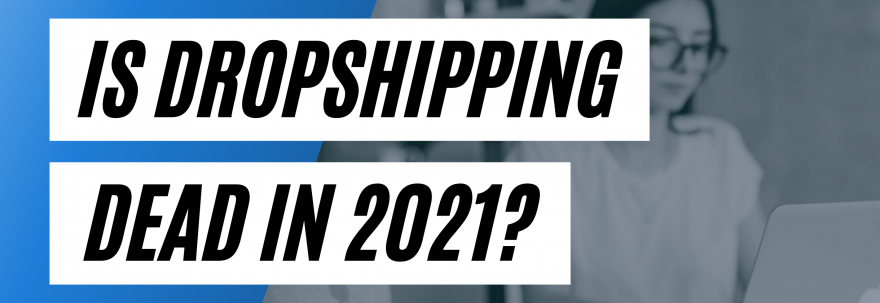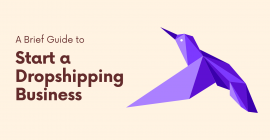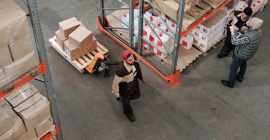The question that is constantly being asked, no matter which year it is. Is dropshipping dead in 2022, 2021, 2020… 2016? The truth is, the answer will always be ”no”. But it depends on your ability to adapt as an entrepreneur.
Due to the low cost of entry as compared to some physical stores, along with the ability to sell without holding on to any inventory, dropshipping quickly caught on amongst people in the eCommerce space.
But with the global market size of dropshipping expected to rise from USD122.3 billion in 2019 to USD149.4 billion by the end of 2020, some would say that the market is getting saturated.
For those who consider dropshipping dead in 2022, you should know that this space is expected to have a compound annual growth rate of 28.8% from 2019 to 2025, reaching USD 557.9 billion by 2025.
If you’re wondering why some people are this optimistic, let’s take a look at some reasons why dropshipping will most likely keep growing in 2022 and beyond:
Increasing Internet Penetration
Up to 49% of the population in developing countries has access to the internet, up from 35% in 2015, according to Statista. This indicates that there could be drastic rises in the number of people using the internet come 2022 and further.
For those running dropshipping businesses, this quickly raises the number of potential customers they can target.
Rising Purchasing Power In Developing Regions
The Credit Suisse Research Institute estimates that compounded retail sales in growing markets such as India, Mexico, South Africa, Turkey, and Russia are at about $3.5 trillion annually.
For dropshippers, this definitely good news seeing as there’s already stiff competition in countries like the US.
A dropshipper can now set up a store with the aim of securing a small piece of the market in different regions rather than catering to only one region.
While the logistics and regulations that come with selling in other countries can be complex, those willing to go through them could stand to establish themselves as the pioneers and dominant brands in those places.
Higher Mobile Phone Usage
The portion of eCommerce sales made on mobile devices was at 34.5% in 2017 and is expected to reach 54% by 2021. Dropshipping business with an eCommerce store that has a responsive theme, passes the thumb-zone test, and is overall mobile-friendly stand to benefit from this increase.
The trend shows a desire to shop on-the-go, and generally achieve a more convenient shopping experience, which is one of the areas that dropshippers can excel at.
Dropshipping allows store owners to delegate a number of tasks such as storage, order processing, and shipping to a 3rd party.
This enables them to focus on making website changes that improve the user experience, run more creative and effective marketing strategies, along with providing excellent customer support.
These attributes will go a long way in boosting sales of eCommerce stores relying on dropshipping down the road. Also remember that in many developing countries, a lot of people are more likely to use smartphones to access the internet since they are more affordable.
At least 40% of online purchases made in Brazil in 2014 were made via mobile, with Indonesia having over 70% of its 2015 online purchases also made using smartphones.
Automated Management Solutions
The continuous technological advancements in various aspects of the dropshipping business show that this model is nowhere near dying out in 2022.
For a lot of day-to-day operations such as searching and importing products, setting prices, processing, and tracking orders, promotions, etc. can all be automated to some extent.
Many service providers including Nimble even offer free trials and a variety of plans/packages to make these advanced solutions accessible to stores of varying sizes.
This shows that there’s an increasing demand for solutions that deal with the repetitive and time-consuming parts of running such businesses. Such trends are bound to attract more dropshippers into this space.
The use of automation in areas such as customer support, with chatbots taking over some of the simpler FAQs and other queries, will also improve customers’ experiences and drive up the adoption of online shopping.
The new trend will involve business owners delegating more of these tasks to one provider.
If you’re looking for a solution that can handle automation of various dropshipping-related tasks, visit Nimble to simplify your entry into this space.
Nimble can easily help you out with:
- Discovering winning products and designing more effective Facebook ads with winning product research tools and ad spy tool.
- Creating high-converting landing pages with a library of templates covering a variety of niches.
- Automating the process of order fulfillment and sending tracking to customers.
- And much more!
Scalability
One of the biggest selling points for dropshipping is scalability. The cost of buying and storing thousands of products can be quite high for a small infant business, even if it is paid in installments.
With dropshipping, it is possible to create an online store and start by fulfilling the demand from their first few customers. With that said, there are many things to consider before scaling your dropshipping business.
As sales go up, the business owner is at liberty to make adjustments to their expenditure in a lot of areas, be it a different store in a different niche, expansion through other types of ads, or in personnel count.
This means that for the foreseeable future, business owners running a dropshipping model have a good chance at breaking even or staying afloat as they gradually learn how to increase their profits.
Warehouse Expansion
In many dropshipping businesses, delivery times can be a big headache both on the store owner’s end, and the customer’s end.
This is partly because it can be difficult finding a good product, and then also landing on a supplier who has a large warehouse network to easily deliver to your target customers.
Never-the-less, the rise of other dropshipping supplier platforms/databases, with some even offering private inventory to high-performing stores along with faster processing and minimal storage fees has caused an awakening.
Many sellers on AliExpress are storing their products in the US and other parts of Europe, with some individual sellers having multiple areas to draw from. Subsequently, they can realize a reduction of up to 6 times when it comes to delivery time.
These developments will also bring more peace in the minds of people who fear that the tariffs and general trade war between the US and China could affect their businesses.
The ultimate result is a stronger effort by smaller ecommerce store owners to compete with the large giants like Amazon in areas where their shipping times were initially hard to beat.
Seasoned dropshippers can also consider using private agents for order fulfillment, but it’s generally recommended that newbies start out with AliExpress.
Favorable Cost Of Products
Due to the fact that the bulk of products on platforms like AliExpress are manufactured in China, large suppliers, or smaller ones that team up to buy in large quantities can get them at low prices.
So even with the competition from other suppliers on these platforms along with additional costs of setting up and promoting their online presence among other expenses, they can still turn a profit.
AliExpress also has a refund policy where these suppliers can reclaim a portion or even their entire annual fees paid if they meet certain sales targets.
Online Payment Processing
In regard to eCommerce stores, there’s usually a strong likelihood of attracting more customers over time if you keep adding new payment methods. While this field was largely dominated by giants like PayPal, there are more payment processors springing up lately.
Ecommerce platforms like Shopify now offer Stripe services and also accept crypto-currencies with the help of intermediaries like Coinbase Commerce, Bitpay, GoCoin, and CoinPayments Beta. Such moves enable people from various parts of the world to shop online.
Even on the side of paying dropshipping suppliers, the traditional methods like VISA and Mastercard are now complemented by other convenient solutions like Qiwi Wallet, Webmoney, DOKU, Ticket, Mercado Pago and Giropay, etc.
These make it easier for dropshippers in different countries to source products from platforms like AliExpress with ease.
Search Engine Entries
The interest in dropshipping as a subject has steadily risen throughout the year, with its worldwide google trends curve for interest over time reaching the 100 mark from 52 in December 2019, and settling at 82 in December 2020.
This significant increase shows that there are more people making searches about dropshipping and trying to learn more, meaning that there’s decent upward momentum when it comes to the overall number of people contemplating such business.
Emerging Niches
Since 2017, there has been a steady increase in the number of people looking for niche products such as handmade gifts, vintage attire, and décor, etc.
This is evidenced by the emergence of formidable platforms like Etsy which focus more on independent sellers in these niches.
Handmade crafts have also made their way onto platforms like AliExpress in an assortment of colors, sizes, themes, styles and materials.
Such handmade products were initially more common in brick and mortar stores and weren’t being produced and distributed in the same way as conventional consumer product goods.
Since more traders can now easily find them online in considerable quantities, a good number of them can focus more on these niches where they have less competition and grow as the culture of shopping for such items online grows.
With Nimble, finding emerging niches is easier than ever before thanks to our product research tools.
Value Addition Services
Many customers are drawn towards stores that can provide extra services such as customization of the products they order. Some service providers such as Printful can print, pack, and ship on behalf of the store owners, making the whole process much smoother.
Designer dropshippers such as Chinabrands have over 30 warehouses spanning the US, EU, HK, and other regions, making it easier for customized products to be delivered to numerous regions.
Others like CustomCat have come up with the so-called “web-to-product manufacturing and fulfillment” to further reduce the cost of selling such products.
The addition of such services by numerous suppliers shows that there is still a strong urge to speak to customers on a deeper level and secure their support.
Furthermore, eCommerce platforms are improving on technology that supports customization, facilitating apps like Customify, Inkbay, and Zakeke.
B2B Growth
Global B2B eCommerce gross merchandise volume has been going up, hitting USD12.2 trillion in 2019, up from USD5.83 trillion in 2013. As B2B eCommerce gains more traction, more dropshipping suppliers could move into this space.
Business-to-business trade enables a lot of stores to move many more units of a product in a single order while also establishing stable relationships through long-term contracts.
There are already entities such as Dropshipping B2B, with others like Leeline complementing dropshipping with product sourcing, factory audit, product inspection, FBA prep, etc.
Other large establishments like bigbuy.eu also have a B2B shop offering wholesale prices and dropshipping services.
Reduced Administrative Tasks
As dropshipping suppliers try to gain more visibility amongst the crowd and sell to more eCommerce retailers, they inevitably cover some of the tedious and expensive activities that go into setting up and continuously running an eCommerce store.
For example, a good number of these sellers are taking professional product photography that takes into account the effects of product photo quality on conversions. These materials are readily available for use upon importing certain products.
The task of filling in product information (names, descriptions, standards certifications, etc.) requires meticulous attention.
It should also be done while considering search engine optimization and the shopper’s experience when trying to go through catalogs and learn about products.
Many dropshipping suppliers list products in a neat manner with all this information readily available and consistently updated, with the ability for changes to be reflected on the retailers’ store quickly.
As the competition ramps up, these suppliers put even more emphasis on other areas such as flexibility in shipping/carrier policies, organization and support in order tracking, parcel delivery modes (split shipping, etc.), and more.
They also improve on the user experience in regard to account setup and selection of additional features/functions, leaving their customers with as few clicks and keystrokes to make as possible.
In the near future, there are a number of factors that will affect the profitability of dropshipping. Some are macro-economic in nature, while others are more particular to dropshipping suppliers and eCommerce customers.
Dropshipping is being boosted by continued innovation in technologies such as cloud computing, 3D configuration and augmented reality, artificial intelligence, etc.
Many of these can be integrated to some extent to achieve more efficiency for the store owners, suppliers and also enrich the customer experience.
Additional web services like Google trends also help merchants to get better insights on what products to sell, and how to reach potential customers through their marketing campaigns. All-in-all, dropshipping is not dead.
It might be a little harder to squeeze substantial profit from certain markets, but costs of entry are still quite friendly and those who are creative and patient enough will soon find a way to do well.




